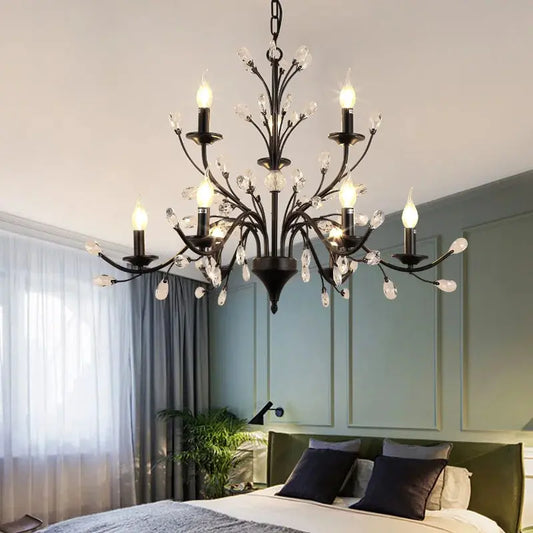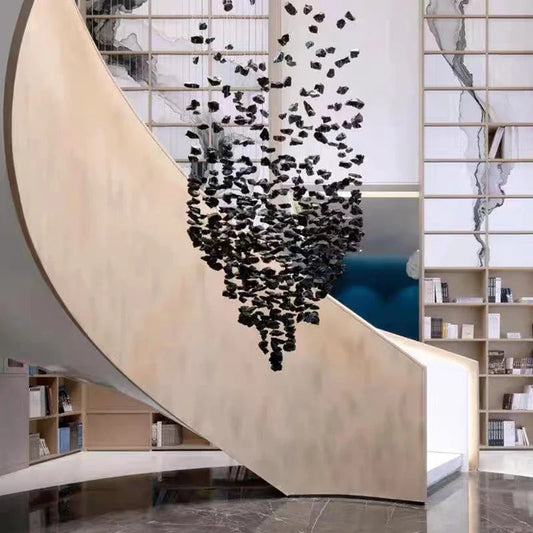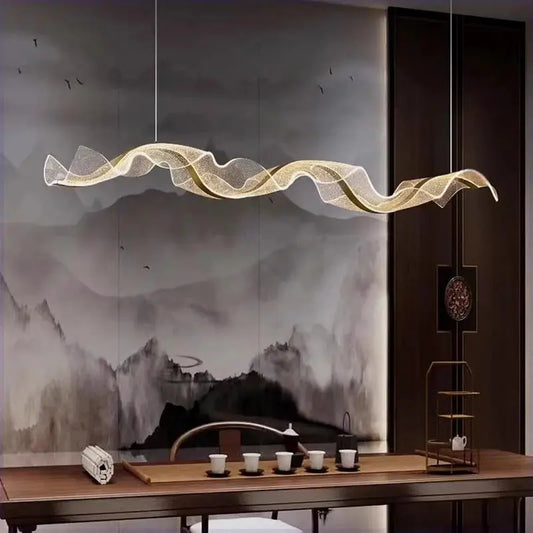Creating a well-coordinated lighting design in your home can make a big difference. By matching chandeliers and pendant lights, you can make your rooms look nice and work well. This guide will help you understand how to pair these two popular lighting fixtures, thinking about things like style, size, and where to put them to make your home feel cozy and look good.
Key Takeaways
| Aspect | Consideration |
|---|---|
| Finish | Match or complement finishes for a unified look |
| Size | Consider room dimensions and ceiling height |
| Style | Maintain a consistent theme while mixing shapes |
| Light Output | Balance illumination between chandeliers and pendants |
| Flexibility | Use dimmers for adaptable lighting options |
Key Points for Matching Chandeliers and Pendants
- Match finishes and styles for a unified look
- Consider room size and ceiling height when selecting fixtures
- Balance light output between chandeliers and pendants
- Mix shapes while keeping a common theme
- Use dimmers for flexible lighting options
Understanding Chandeliers
Chandeliers are big, eye-catching lights that can be the main focus in a room. They come in many styles, from old-fashioned crystal ones to more modern designs. When picking a chandelier, think about how big your room is and how high the ceiling is. A good rule is that the chandelier should be about one-third as wide as the dining table or room it's hanging over.
Crystal chandeliers are a classic choice that can make any space look fancy. Crystal chandeliers work well in fancy dining rooms or entryways. For a more modern look, you might like a chandelier with simple lines and unique shapes. The size of the chandelier should fit the room - a big chandelier might look too big in a small room, while a small one might look too small in a big room.

Exploring Pendant Lights

Pendant lights are lights that hang from the ceiling on a cord, chain, or rod. They come in many styles, from single lights to designs with multiple lights. Pendant lights are great for lighting specific areas like kitchen islands, dining tables, or reading corners. When choosing pendant lights, think about what they're made of and how they look, so they match your other decorations and lights.
Single pendants work well for lighting small areas, while multi-light pendants can light up bigger spaces. Bubble chandeliers are a popular type of multi-light pendant that can add a fun, modern touch to your room. When hanging pendant lights, they should usually be 28-34 inches above a surface to look good and provide the right amount of light.
How to Match Chandeliers and Pendants
The key to making chandeliers and pendants look good together is to create a matching look while still letting each light stand out. Here are some tips to help you pair these lights well:
1. Coordinate Finishes
Choose lights with similar finishes or colors that go well together. For example, if your chandelier is brushed nickel, look for pendant lights that are the same or a similar metal color. This makes your lighting design look unified. But don't be afraid to mix metals if you do it carefully - a brass chandelier can look good with bronze pendants if the overall color scheme is warm.
2. Balance Sizes and Proportions
Make sure your chandelier and pendant lights are the right size for each other and the room. A big chandelier with tiny pendants might look odd. Similarly, really big pendants could make a delicate chandelier look too small. Think about how big your furniture is and the size of your room when choosing your lights.
3. Maintain a Consistent Style
Your lights don't need to match exactly, but they should have some things in common. For instance, if you have a modern chandelier with geometric shapes, choose pendant lights with similar angular shapes. This creates a harmonious look throughout the space while still allowing for some variety.

Matching Techniques for Different Rooms
Dining Room
In the dining room, a chandelier is often the main light. You can add pendant lights over a sideboard or in corners to provide extra light and make the room more interesting. Choosing the right chandelier for your dining room is important for setting the mood and providing enough light for meals. Think about the shape of your dining table when picking a chandelier - a round chandelier works well with a round table, while a rectangular or oval chandelier looks good over a long dining table.
Kitchen
In the kitchen, try using pendant lights over an island or breakfast bar, with a matching chandelier in the dining area next to it. This creates a nice flow between the spaces while keeping each area distinct. For kitchen islands, a good rule is to use one pendant for every two feet of counter space. This ensures the light is spread evenly and looks balanced.
Foyer and Entryway
A big chandelier in the foyer can make a strong first impression. Pair it with smaller pendant lights along a hallway or staircase to guide the eye and provide consistent lighting throughout the space. For two-story foyers, consider a multi-tier chandelier that can fill the tall space effectively.

Mixing Different Styles
Don't be afraid to mix different styles of chandeliers and pendants. This can create an interesting, layered look in your home. Here are some ideas:
- Combine modern and traditional elements for a mixed look
- Use complementary shapes and forms to create visual interest
- Play with contrasts in color or material to add depth to your lighting design
When mixing styles, try to find something that ties the lights together. This could be a similar finish, a repeated shape, or a shared color. Remember that the goal is to create a cohesive look, not a matching set.

Lighting Layout and Placement
Putting your chandeliers and pendants in the right place is just as important as how they look. Here are some guidelines to follow:
- Hang chandeliers about 30-36 inches above a dining table for the best light spread
- Space pendant lights evenly, about 30 inches apart, over kitchen islands or bars
- In living rooms, hang chandeliers at least 7 feet from the floor so people don't bump their heads
Remember to create the right atmosphere in your dining room by carefully thinking about where to put your lights and what style to choose. The height of your ceiling should also influence your choice of fixtures - for rooms with high ceilings, consider longer chains or rods to bring the light closer to eye level.
Energy Efficiency and Smart Lighting
When picking chandeliers and pendant lights, think about energy-efficient options to save on electricity bills and help the environment. Here are some tips:
LED Bulbs
Choose LED bulbs for long-lasting, energy-efficient lighting
Dimmer Switches
Install dimmer switches to control light levels and save energy
Smart Lighting
Look for smart lighting options that can be controlled via smartphone or voice commands
LED bulbs are a great choice for chandeliers and pendants because they use less energy and last longer than old-fashioned light bulbs. They also don't get as hot, which is good in smaller spaces. Smart lighting systems let you control your lights with your phone, set schedules, and even change the color of the light to match different times of day or moods.
Maintenance and Care
To keep your chandeliers and pendant lights looking their best, you need to take care of them regularly:
- Dust the lights often with a soft, dry cloth
- For crystal chandeliers, use a mixture of one part rubbing alcohol to three parts distilled water for cleaning
- Replace bulbs quickly when they burn out to keep the lighting consistent
- Think about get professional cleaning for big or complex chandeliers once a year
For crystal chandeliers, be careful when cleaning the crystals so you don't chip or break them. Always turn off the power to the light before cleaning or changing bulbs. If your chandelier or pendant has fabric shades, use a lint roller or soft brush to gently remove dust and dirt.
Conclusion
Matching chandeliers and pendant lights can make your home's lighting look great and work well. By thinking about things like finish, size, style, and where to put them, you can create a look that's both useful and beautiful. Remember to balance your lighting choices with the overall design of your space, and don't be afraid to mix different styles for a unique look. With the right combination of chandeliers and pendants, you can change the feel of any room in your home.
For more ideas and a wide selection of lighting options, check out Seus Lighting's chandeliers and pendant lighting collections. With careful planning and the right fixtures, you can create a lighting scheme that really stands out, making your living spaces look better and work better for years to come.










